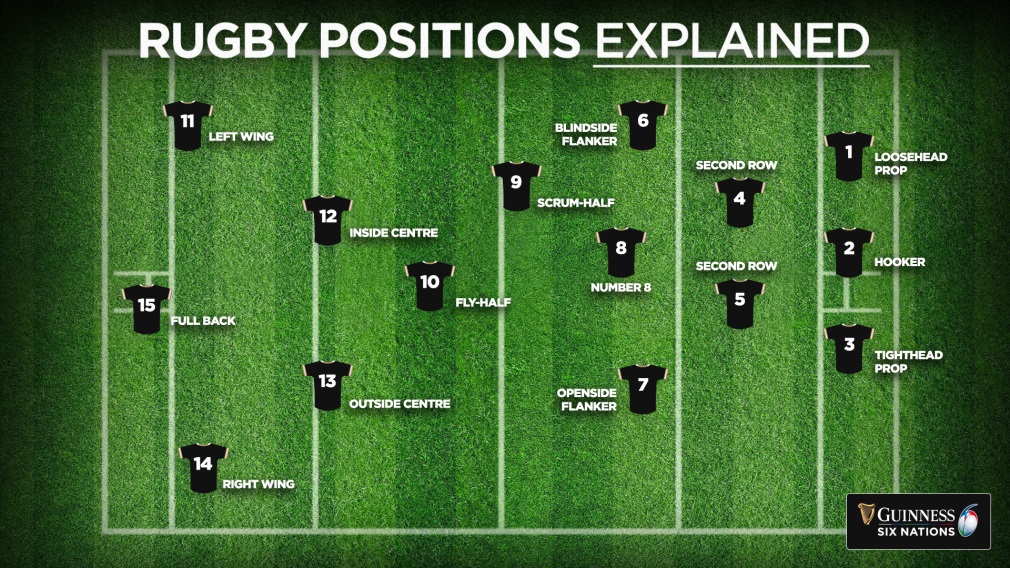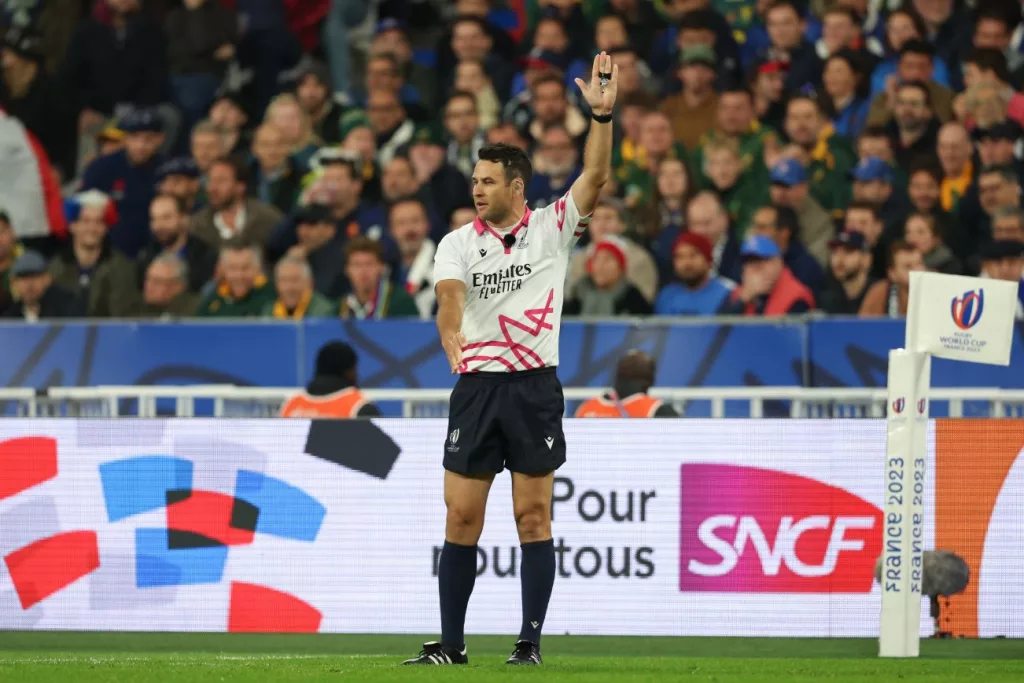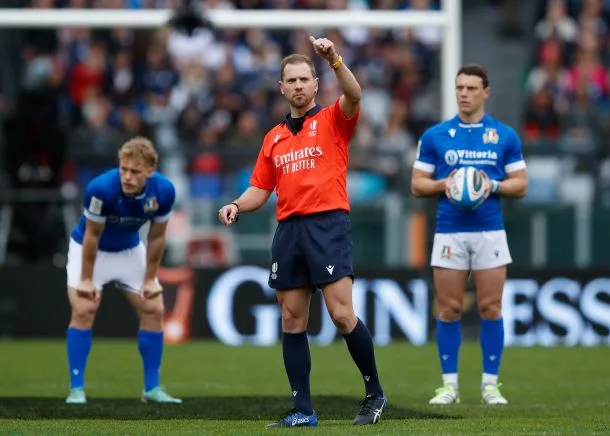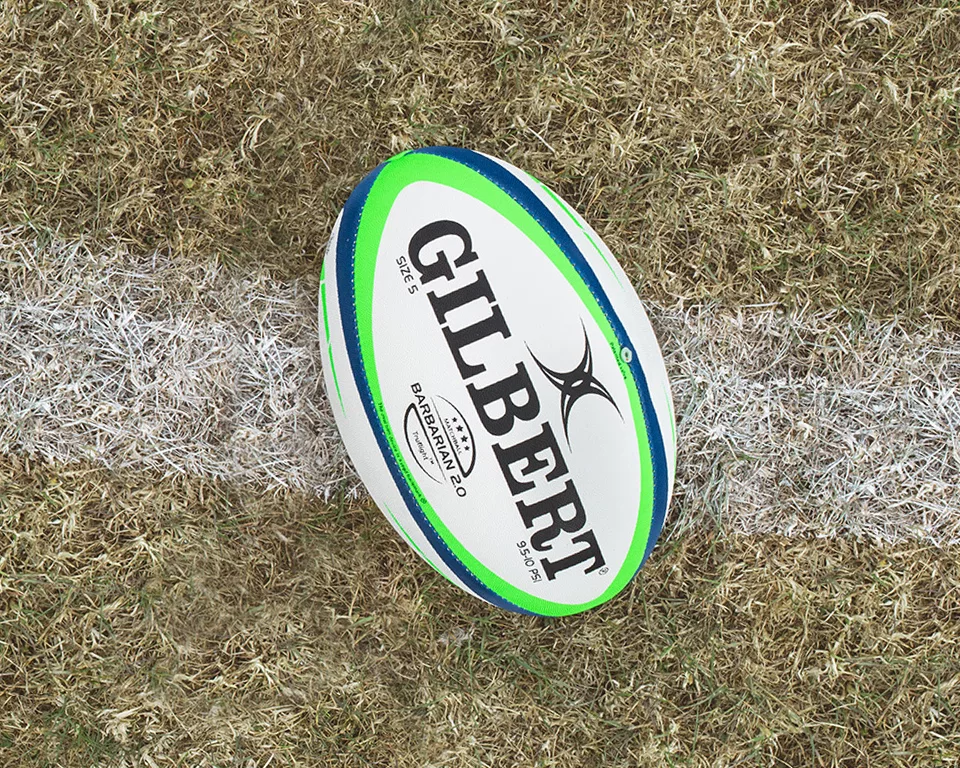Welcome to the adrenaline-fueled world of rugby! This is a sport that will have you on the edge of your seat, heart pounding, as you watch two teams battle it out on the field. New to the game? Don’t sweat it! We’ve got you covered.
At The Full 80, we’ve taken the initiative to simplify your introduction to the game. We’ve consolidated the rules and the mechanics of the game in one convenient location, saving you the trouble of searching elsewhere!
So, let’s get to it!
Skip To:
#2. Understanding Player Positions
#3. Getting to Grips with the Rules
#4. Rugby Points & Scoring Explained
#5. How Fouls and Penalties are Calculated in Rugby
#6. The Referee’s Word is Final!
#7. Ensuring You’re Well Equipped for the Game

#1. What is the objective of rugby?
In the simplest terms, rugby is a strategic battle where two teams vie to outscore each other within a span of 80 intense minutes. The team with the most points at the final whistle takes home the glory, but remember, games can also end in a nail-biting draw.
The clock is relentless, divided into two halves of 40 minutes each, with a brief 10-minute respite for half-time. Unlike football, there’s no added time for stoppages – when the clock hits 80, the game is over, no exceptions.

Each team fields 15 warriors, with up to 7 substitutes waiting in the wings. Once a player leaves the field, they can only return if they were taken off for injury treatment.
Rugby is a game of grit and determination, with no room for theatrics or time-wasting. It’s all about what happens in those 80 minutes of pure, unadulterated action.
#2. What are the player positions in Rugby?
A rugby team is a well-oiled machine, made up of 15 players, each with a specific role to play.
The team is split into two groups – the Forwards and the Backs.
Forwards, wearing jerseys numbered 1 to 8, are the powerhouses of the team. They’re typically larger, stronger, and might not be the fastest, but they’re the ones doing the heavy lifting – tackling, rucking, and hitting.
Backs, donning jerseys 9 to 15, are usually smaller and more athletic than their forward counterparts. They’re the playmakers, responsible for creating offensive opportunities and preventing defensive breaches. Their game is all about speed, agility, and a deep strategic understanding of rugby.
With us so far?
Good, as things are about to get a little more complicated if you’re new to the game.
Of the 15 players, there are 8 Forwards split up into the positions of:
- Prop (#1, #3)- Provides stability in the scrum whilst supporting the hooker to help win the team the ball. Also responsible for supporting the jumper in the Line Out.
- Hooker (#2)- Responsible for “hooking” the ball and obtaining possession of it during a Scrum (More on this later).
- Second Row (#4, #5)- Players who relish contact and responsible for helping to win the ball at Lineouts, whilst helping to lock the scrum into position.
- Flanker (#6, #7)- One of the most important roles in the game. Responsible for securing and maintaining possession of the ball, usually following rucks and Mauls. Also assists in pushing the scrum.
- Number 8 (#8) – Executes big tackles against the opposition, whilst responsible for carrying the ball through the defensive line and provide essential support to the backs.

Whilst the second split is formed of 7 players known as ‘Backs‘. These are split up into the positions of:
- Scrum Half (#9) – An essential link between the Forwards and Backs & a player responsible for making on-the-spot decisions to help link play, execute key passes and kick accurately.
- Fly Half (#10)- Usually fed the ball by fellow Half-Back and Scrum-Half players. They direct and orchestrate the attack and defence of the other backs. Runs, kicks and passes made by the Fly Half are used to initiate attacks by other backs.
- Wingers (#11, #14) – Powerful and fast, wingers are responsible for evading the defenders of the opposing team, chasing down drop kicks , and performing tackles so as to prevent the opposing team from scoring a try.
- Inside Centre (#12) – Responsible for finding and creating spaces when attacking so as to dominate the gain line. Fundamental in carrying the ball, winning collisions and for picking up crucial yards in gameplay.
- Outside Centre (#13)- Powerful and quick, they break through the oppositions defenses and create space for players outside of them, whilst working closely with the Inside Centre to co-ordinate attacks.
- Full Back (#15)- Known as the last line of defence, they tackle the opposition and collect the ball from any unsuspecting kicks that make their way past their teammates’ defensive line.
#3. What are the Rules of Rugby?
Everyone is Equal
In the thrilling world of Rugby, everyone is on an equal footing. Each player, regardless of their position, has the opportunity to run with the ball and face the challenge of tackles. This is a stark contrast to American Gridiron football, where only a select few get the chance to make a run for glory.

Did you know? On average, each player makes around 20 runs and tackles per game!
The Art of Ball Movement
Every pass is a strategic move. The ball must always be pitched backwards to your teammates – no forward passes allowed. Beware, even an accidental forward drop or nudge can result in a penalty, typically leading to a scrum (more on this later).

But remember, you can pass the ball among your team as much as you want!
No Room for Obstruction
There’s no place for obstruction. Players cannot assist their teammates by blocking off opponents. If you’re caught doing so, you’ll be penalised with a kick offense.
This rule is particularly important during Rucks and Mauls, where players from both teams are closely engaged in a contest for the ball.
But what are Rucks & Mauls?
Rucks: A ruck occurs when one or more players from each team come together over the ball on the ground, usually following a tackle. Players on their feet must bind onto the ball and each other, attempting to secure possession for their team. The ruck ends when the ball emerges from the back of the ruck or when a penalty is awarded.
Mauls: On the other hand, a maul arises when a player carrying the ball is held by one or more opponents, and their teammates bind onto them, creating a forward-driving contest. The ball remains off the ground, held up by the players’ bodies. The objective is for the team in possession to drive forward while protecting the ball, with their teammates pushing them from behind.

Both rucks and mauls are pivotal moments in the game, where teams vie for possession and territory, often requiring physical strength and strategic prowess.
The Power of Scrums & Lineouts
Scrums: A scrum is a key part of Rugby, where players from both teams bind together and compete for the ball. It usually occurs after certain infractions or stoppages. In a scrum, the forwards from each team bind together and push against the opposing team to gain possession of the ball. The scrum-half of the non-offending team feeds the ball into the scrum, and the battle for possession begins!

Lineouts: When the ball goes out of bounds, a lineout is awarded to the non-offending team. Players from both teams line up perpendicular to the touchline, and a teammate throws the ball into the air. Players are lifted to catch the ball, and the team that wins possession often gets the chance to launch an attacking move.

The Discipline of Yellow & Red Cards
In Rugby, discipline is enforced through yellow and red cards. A serious infraction or repeated rule violations can earn a player a yellow card, leading to a temporary suspension, typically for 10 minutes. A red card, however, results in the player being sent off for the rest of the match.

Dangerous tackles, foul play, or dissent towards the referee’s decisions are common reasons for receiving cards.
The Skill of Tackling & Referee Signals
Tackling:
Tackling is more than just a skill – it’s an art. But remember, it’s an art that must be practiced safely and within the rules. Players aim to wrap their arms around the ball carrier, bringing them down in a safe yet effective manner.

High tackles and dangerous tackles are strictly off-limits and can lead to penalties or even disciplinary action. So, play hard, but play fair!
Decoding Referee Signals:
Referees are the conductors of the rugby symphony, using a variety of signals to communicate with players and spectators. These signals are your key to understanding the game’s decisions and following the game effectively.

So, keep your eyes on the referee and learn to interpret these signals! It’s like learning a new language – the language of Rugby!
#4. How does scoring in Rugby work?
Forget what you know about football, 1 touch to the try line, or a boot of the ball over the H post doesn’t equate to 1 score point..
No, there are actually numerous ways in which to score points:
- Penalty Kick – Awarded in the event of foul play to the opposing team and worth 3 points if successful. The rugby ball is placed on a kicking tee where the appointed kicker must kick the ball between the goal posts and over the crossbar.
- Drop Goal – Performed by the player dropping the ball and then kicking it as it hits the ground over the crossbar and between the goal posts. To qualify the ball must not touch the ground again before it makes the goal posts. Touching the crossbar or posts is permitted. Like the penalty kick, this is also worth 3 points.
- Try – Worth 5 points, in order to score a Try, players must place the ball on or behind the oppositions Try-line which is located on the line of the goal posts.
- Conversion– This is when a free kick is awarded after a team score a Try. With the possibility of gaining an extra 2 points (7 total), the player must kick the ball between the goal posts and over the crossbar (the same as if taking a penalty kick).
- Penalty Try: In cases where a player would likely have scored a try but for foul play by the opposing team, a penalty try is awarded. It is worth 7 points and is placed under the posts, with no conversion required.
#5. How are Fouls and Penalties calculated in Rugby?
In Rugby, fouls and penalties are calculated in accordance with the rules of the game and consist of the following:
Rugby Infringement
This refers to a term used in rugby that is used to describe any moment in the game when a player is seen to break the rules.
It can be for a number of many different reasons such as:
#1. Being Offside– A player is considered to be offside if they are further forward (nearer to the opponents’ goal line) than the teammate who is carrying the ball or the temmate who last played the ball.
#2. Advantage Rule – The advantage rule allows the game to continue when an infringement occurs. If the non-offending team gains territory or a try-scoring chance, the game continues. If not, play is called back.
#3. Punching – If a player punches or strikes another player with their hand, arm, elbow or shoulder.
#4. Collapsing a Maul– Players involved in a maul must have their heads/shoulders no lower than their hips and must have at least one armour bound to a team-mate. Failing this, the team not in possession of the ball cannot deliberately collpase the maul.
Penalties & Free Kicks
In order to restart the game after an infringement has been made, the referee awards a penalty or a free kick towards the team that the infrigement has been made against.

The Seriousness of Penalties
In the world of rugby, penalties are not taken lightly. They are often awarded when players fail to release the ball on the ground, do not move away from the tackler, collapse mauls, or are caught offside.
The penalty can be taken in several ways:
- Kicked to touch, with the kicking team throwing the ball into the lineout.
- Used to attempt to score three points by place-kicking the ball through the posts.
- Taken quickly with a quick tap to restart the game.
- Converted into a scrum at the Captain’s request.
Remember, penalties are reserved for more serious offences, such as violent conduct, professional fouls, and deliberate knock-ons. If a player chooses to kick for the goalposts, they will be awarded three points if the ball is successfully kicked over the crossbar and between the posts.
The Subtelties of Free Kicks
Free kicks in rugby work slightly differently. They cannot be kicked directly into touch and cannot be place kicked for goal. Instead, a player must tap the ball with their foot, which instantly restarts the game.
Note that free kicks are typically reserved for more minor infringements such as wasting time in a scrum or having the wrong number of players. So, while they may seem less severe, they still play a crucial role in maintaining the flow and fairness of the game.
In the end, whether it’s a penalty or a free kick, every decision in rugby carries weight and contributes to the overall strategy and outcome of the game. So, play wisely and respect the rules!
Why are Penalties & Free-Kicks so important in rugby?
Conceding penalties and free-kicks through either ill-discipline or through pressures from the opposition can be a major deciding factor in the outcome of rugby matches.

If you’ve had your eyes on the recent 2024 Six Nations Championship, then you’ll likely have seen this be the case with Italy’s Paolo Garbisi, where he failed to lead his team into victory after a failed penalty attempt against France.
Check it out for yourself!
Injuries and substitutions:
Rugby is a physically demanding sport, and injuries are not uncommon…
When a player is injured and needs to leave the field, they can be replaced by one of the substitute players waiting on the sidelines. Each team is typically allowed a certain number of substitutions per match, and temporary substitutions may be allowed for blood injuries.
These replacements ensure that teams can maintain their competitive edge even in the face of injuries.
#6. Referee’s Authority
It may be self explanatory for some, but for those who are new to the game, it’s important to note that the referee’s decisions are final and must be respected by the players and coaches.
Disputing or showing dissent towards the referee’s decisions can result in penalties or disciplinary action.

#7. What Equipment am I allowed to Use for Rugby?
While rugby is known for its physicality, players are required to wear certain equipment for safety. The most essential piece of equipment is the rugby ball itself, but players also wear specialized footwear designed for the conditions of the playing surface.

Additionally, while not mandatory, many players choose to wear protective gear such as mouthguards and headgear to reduce the risk of injury during play. These pieces of equipment help ensure that players can compete safely and confidently on the field.
